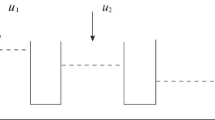A model of a virtual sensory system consisting of a set of physical and virtual sensors and a supervisor is presented. Levels of the hierarchy for each type of sensor are considered. At the physical level of integration, a uniform interface is provided along with access to specific devices, while at the virtual level data are provided for the upper level and the supervisor.
Similar content being viewed by others
References
T. C. Henderson and E. Shilcrat, “Logical sensor systems,” J. Robotic Systems, No. 3, 169–193 (1984).
T. C. Henderson, C. Hansen, and B. Bhanu, “The specification of distributed sensing and control,” J. Robotic Systems, No. 3, 387–396 (1985).
M. Erdmann, “Understanding action and sensing by designing action-based sensors,” Int. J. Robotics Research, 14, No. 5, 483–509 (1995).
H. R. Nicholls, J. J. Rowland, and K. A. I. Sharp, “Virtual devices and intelligent gripper control in robotics,” Robotica, 7, No. 3, 199–204 (1989).
J. J. Rowland and H. R. Nicholls, “A virtual sensor implementation for an assembly machine,” Robotica, 13, No. 4, 195–199 (1995).
N. D. Duffy, J. T. Herd, and H. J. Eccles, “Agents get framed in novel architecture,” Industr. Robot, 18, No. 2, 23–26 (1991).
M. Minsk, The Society of Mind, London (1988).
N. Hardy and A. A. Maroon, “VISIAr – A virtual sensor integration architecture,” Robotica, 17, No. 5, 635–647 (1999).
M. Dekhil and T. C. Henderson, “Instrumented sensor system architecture,” Int. J. Robotics Research, 17, No. 4, 402–417 (1998).
T. A. Wenzel et al., “Kalman filter as a virtual sensor applied to automotive stability systems,” Trans. Institute Measure and Control, 29, No. 2, 95–115 (2007).
A. G. Topekhin, “Use of an adaptive Kalman filter in problems of orientation of mobile objects,” Inform.-Izmer. Upravl. Sistemy, 4, No. 1–3, 63–66 (2006).
A. A. Kirilchenko and A. A. Petrin, “The property of virtuality in information robot engineering systems,” Preprint No. 41, Keldysh Institute of Applied Mathematics, Russian Academy of Sciences, Moscow (2003).
A. A. Petrin, “Organization of virtual sensitization for problems of robot engineering,” Preprint No. 42, Keldysh Institute of Applied Mathematics, Russian Academy of Sciences, Moscow (2003).
A. V. Akhterov et al., “Implementation of the conception of virtual sensors in information-measurement systems,” Inform.-Izmer. Upravl. Sistemy, 7, No. 6, 72–76 (2009).
Author information
Authors and Affiliations
Corresponding author
Additional information
Translated from Izmeritel’naya Tekhnika, No. 9, pp. 17–21, September, 2010.
Rights and permissions
About this article
Cite this article
Petrin, A.A. Virtual sensors for use in information measurement systems. Meas Tech 53, 964–969 (2010). https://doi.org/10.1007/s11018-010-9605-8
Received:
Published:
Issue Date:
DOI: https://doi.org/10.1007/s11018-010-9605-8




